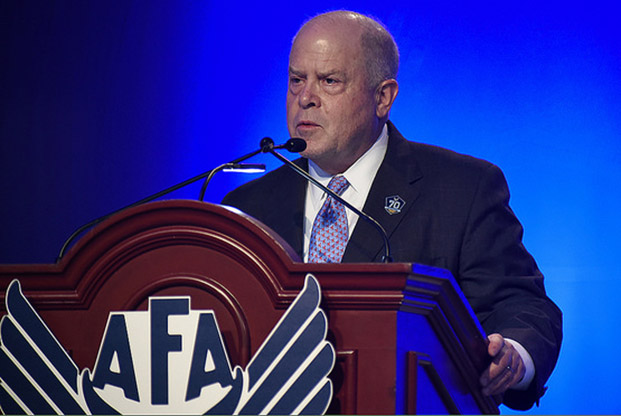
AFA's chairman of the board, former Air Force Secretary Whit Peters—shown here at the 2018 Air, Space & Cyber Conference—says that DOD's current milspace plans don't justify the need for "a separate Space Force." Staff photo by Mike Tsukamoto.
The Air Force Association opposes creating a separate military service dedicated to space but supports plans to reestablish US Space Command, according to a new policy statement released on Wednesday. The Association publishes Air Force Magazine.
The statement is a response to plans outlined last month by Vice President Mike Pence, who outlined the administration’s plans to create a sixth branch of the Armed Forces dedicated to space by 2020, the first such move since the US Air Force was established in 1947. “Just as in the past, when we created the Air Force, establishing the Space Force is an idea whose time has come,” Pence said at the time, arguing that space has become “crowded and adversarial.”
AFA counters that the US military is still developing the tactics, techniques, and procedures for operating in the space domain, and further national debate is necessary before space weapons are deployed and a new service should be established, according to its statement.
“If our nation decides to deploy military weapons in space, that decision might justify a separate Space Force, but current plans do not go that far,” said AFA’s chairman of the board, former Air Force Secretary Whit Peters. “Instead, the need is for constellations designed with systems to defeat adversaries’ kinetic, electronic, and cyber countermeasures. This will certainly require some new systems and will certainly require trained space operators capable of employing defensive measures.” Rather than a new service, he added, “A unified command supported by a rapid acquisition office should be sufficient to meet those requirements.”
Air Force Secretary Heather Wilson estimated the cost of creating a new service to be roughly $13 billion over the course of the five-year future years defense program, telling reporters last week at AFA’s Air, Space & Cyber conference that her estimate was “conservative” and based on a total end strength of 13,000 personnel, including a headquarters of about 2,400.
AFA President Larry Spencer, a former vice chief of staff of the Air Force, said it would be more cost effective to invest that money in bolstering the National Security Space portfolio.
“Creating a separate space force will drain billions of dollars in resources from current and future readiness. A new headquarters, and all the accouterments that accompany it, is not a cost-effective way to enhance military capability nor to improve space operations,” Spencer said.
The Air Force Association also questioned the need for a new Space Development Agency, which the administration has said would be tasked with rapidly developing and fielding new technologies. According to a Pentagon report released the same day as Pence’s August speech, the agency would be modeled after the Air Force’s Rapid Capabilities Office and would concentrate resources on significant breakthroughs in space. Deputy Defense Secretary Patrick Shanahan told reporters last month that resources currently allocated to USAF’s Space and Missiles Systems Center, which manages some 85 percent of DOD’s space acquisition budget, would be reallocated to the new agency.
“AFA questions whether the creation of a Space Development Agency will add any real value when the primary issue for space—and for all other major weapon systems—is accelerating the acquisition process to allow more rapid fielding of advanced systems,” the association stated. “Existing defense agencies have certainly not been models of efficiency and innovation. Applying rapid acquisition concepts to space systems would be a more direct approach to accelerating the fielding of new space systems.”